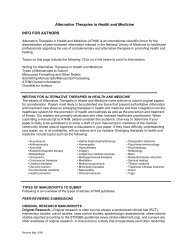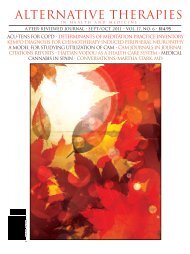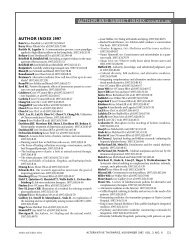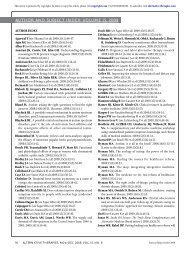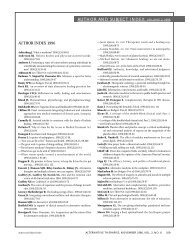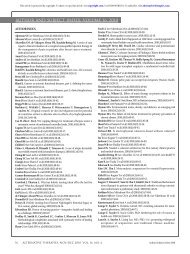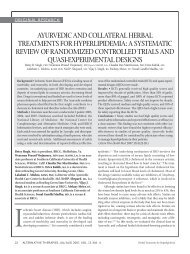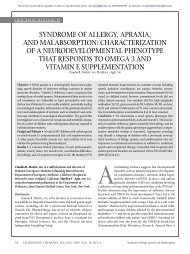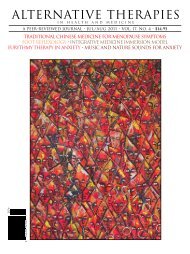Alternative Therapies In Health And Medicine
Alternative Therapies In Health And Medicine
Alternative Therapies In Health And Medicine
Create successful ePaper yourself
Turn your PDF publications into a flip-book with our unique Google optimized e-Paper software.
case report<br />
Eurythmy Therapy in Anxiety<br />
Jane Hampton Schwab; John Bernard Murphy; Peter <strong>And</strong>ersson, MD; Gunvor Lunde, MD; Helmut Kiene, MD;<br />
Harald Johan Hamre, MD; Gunver Sophia Kienle, MD<br />
Anxiety is a highly frequent condition; many patients seek<br />
complementary treatment. One of these is anthroposophic<br />
medicine (AM) using therapeutic approaches that are based on<br />
a distinct concept of the human organism, illness, and healing.<br />
AM is applied in anxiety; however, little is known about underlying<br />
therapeutic concepts, the effectiveness, and the modalities<br />
of clinical reasoning and judgment.<br />
Presented is a 21-year-old woman who had suffered from<br />
severe and increasing anxiety for 6 months, which had led to<br />
social isolation and complete sick leave from work. She had<br />
attended an AM health care center and counseling at a psychiatric<br />
hospital but had not improved significantly after 6<br />
months. Eurythmy therapy (EYT) was then applied for 8<br />
weeks. Within the AM pathophysiological context, the patient<br />
was diagnosed as having stress-induced anxiety based on a<br />
juvenile disturbance of the rhythmical system. Associated<br />
symptoms were specific anomalies in the patient’s eurythmy<br />
movement pattern, a “breathed-in-upwards syndrome.” <strong>In</strong> the<br />
EYT sessions, clear interconnections between EYT-exercises<br />
and symptom-relief were observable, paralleled by a substantial<br />
relief of the patient’s anxiety.<br />
EYT might have some impact on anxiety syndrome and<br />
should be investigated in more detail. (Altern Ther <strong>Health</strong> Med.<br />
2011;17(4):58-65.)<br />
Jane Hampton Schwab is an eurythmy therapist (Dipl); John<br />
Bernard Murphy is an eurythmy therapist (Dipl); and Peter<br />
<strong>And</strong>ersson, MD, is a specialist for general medicine at the Vidar<br />
Clinic Foundation, Järna, Sweden. Gunvor Lunde, MD, is a consultant<br />
psychiatrist in the Department vor Psychosis and<br />
Rehabilitation, Sanderud Hospital, Norway. Helmut Kiene, MD,<br />
Harald Johan Hamre, MD, and Gunver Sophia Kienle, MD, are<br />
senior scientists at the <strong>In</strong>stitute for Applied Epistemology and<br />
Medical Methodology, Freiburg, Germany.<br />
Corresponding author: Gunver Sophia Kienle, MD<br />
E-mail address: gunver.kienle@ifaemm.de<br />
Anxiety disorders are increasingly recognized as a<br />
major health concern, often underdiagnosed and<br />
undertreated, and with substantial disability, reduced<br />
quality of life, reduced work capacity, and increased<br />
health care use. 1-6 About 6% to 19% of adults in the<br />
West are affected every year, and about 10% to 29% are affected during<br />
their lifetimes. 7,8 Subtypes of anxiety disorders include generalized<br />
anxiety disorder, panic disorder, specific phobias,<br />
obsessive-compulsive disorder, social anxiety disorder, and posttraumatic<br />
stress disorder. 9 Generalized anxiety disorder is characterized<br />
by persistent, excessive, and unrealistic worry about<br />
everyday things. It is accompanied by various symptoms: of autonomic<br />
arousal (eg, palpitations, sweating, trembling), in the chest<br />
and abdomen (eg, difficulty breathing, chest pain, nausea, diarrhea),<br />
of mental state (eg, dizziness, feelings of unreality, fear of<br />
dying, difficulty in concentrating), and general symptoms (eg, muscle<br />
tension, numbness or tingling, aches and pains, hot flushes or<br />
cold chills, restlessness, fatigue) and sleep disturbance. 10 Treatment<br />
options are medication (selective serotonin reuptake inhibitors, tricyclic<br />
antidepressants, benzodiazepines, and others) and psychotherapy,<br />
especially cognitive behavioral therapy, relaxation therapy,<br />
and self-help approaches. 10,11 However, not all patients benefit from<br />
these treatment options. Even under the optimal conditions of a<br />
clinical trial, 20% to 60% of the patients do not improve.<br />
Furthermore, anxiety disorders have a relapsing course, and medication<br />
alone rarely leads to complete recovery. 10,12-16<br />
About half of the patients with anxiety use complementary<br />
and alternative medicine (CAM). 17,18 One CAM system is anthroposophic<br />
medicine (AM), founded by Rudolf Steiner and Ita Wegman<br />
in the early 20th century. 19,20 It is based on a specific understanding<br />
of the human organism, with particular concepts of pathophysiology<br />
and therapeutic intervention. AM is presently practiced as integrative<br />
medicine (integrated with conventional medicine) in most<br />
European countries, the Americas, some African and Asian countries,<br />
Australia, and New Zealand. AM is offered in hospitals (currently<br />
28 specialized AM hospitals), outpatient clinics, and<br />
practices. It is provided by physicians, nurses, and therapists.<br />
Specific AM treatments include medication, movement (eurythmy<br />
therapy [EYT]), rhythmical massage, anthroposophic art therapy<br />
(music, painting, poetry, sculpture), and specific counseling that<br />
relates to nutrition, lifestyle, coping strategies, biographicexistential<br />
aspects, and social aspects of illness. <strong>In</strong> addition, there<br />
are special AM nursing techniques. 20 Treatment of mental disorders<br />
is a focus of AM health care, 21 especially in primary care but also in<br />
specialized departments or psychiatric hospitals. A prospective<br />
cohort study in 2009 assessed outcome of patients treated for anxiety<br />
disorders in outpatient settings by AM, including EYT, art, and<br />
massage therapies, consultations by AM doctors, and special AM<br />
medication. A long-term improvement of anxiety was observed<br />
56 ALTERNATIVE THERAPIES, jul/aug 2011, VOL. 17, NO. 4 Eurythmy Therapy in Anxiety



